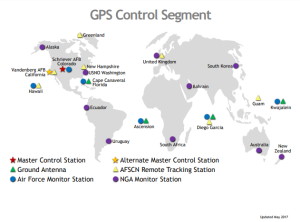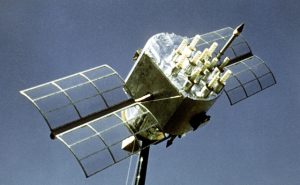22 The Global Positioning System
Lauren Zarrella
22.1 Introduction
Keywords
- Aviation- the flying and operating of aircraft
- Constellations- a group of stars forming a pattern
- Satellite- artificial bodies placed in space to collect information
- Sputnik- the first satellite to successfully orbit Earth in 1957
Learning Objectives
By the end of this chapter, students should be able to:
- Understand what the Global Positioning System is and how it has evolved over time
- Understand the pros and cons of the Global Positioning System on the Millennial generation
- Describe how the Global Positioning System is still used today
Have you ever wondered how hard it would be to go to a place for the first time without any sort of directions? Using a compass and a paper map like people did back in the days is not the easiest and most convenient thing to do. Thankfully, the Global Positioning System was created to make our lives a lot easier. Most people in our society today use the Global Positioning System (GPS) to navigate their everyday lives, but do we really know how this piece of technology works?
The Global Positioning System is a satellite-based navigation system that was first created in 1973 by the Department of Defense. (DoD). It was originally created for military use, but soon became accessible to the public. The Millennial generation has been greatly impacted by this technology as it has evolved greatly and is still being used today. This chapter will focus on what the Global Positioning System is, how and why it came to be, its impact on the Millennial generation, and how it is still used today. The Global Positioning System has changed the way Millennials communicate and navigate their lives while it also has created some adverse consequences such as terrorism.
22.2 What is the Global Positioning System?
Key Takeaway
The Global Positioning System is a satellite-based navigation system and precise-positioning tool that was first created by the Department of Defense (DoD) in 1973. The GPS consists of three segments: the space segment, the control segment, and the user segment. The space segment consists of 24 satellites, artificial bodies placed in space to collect information, that orbit 20,200 km above the earth. These satellites are divided into six groups of four to make sure they can be detected anywhere on Earth’s surface. The control segment tracks the GPS satellites, monitors the transmissions made by the satellites, analyzes the data, and sends commands to constellations, a group of stars forming a pattern. The user segment includes any type of device or equipment that receives the signals.

“Control Segment “ by United States Government is in the Public Domain

“User Segment” by United States Government is in the Public Domain
The Global Positioning System was originally created by the United States for military purposes such as determining a location in vehicles, planes, and ships. On December 8, 1993, the Global Positioning System was made available to the public for civilian use. Civilians can use the GPS for free throughout the entire world. Although more commonly used by civilians, the Global Positioning System is still used by the United States military and their allied armed forces.
22.3 History of the Global Positioning System
Key Takeaway
The Global Positioning System was originally created for military use but soon became available to the public.
Prior to the creation of the Global Positioning System, scientists tracked satellites in regards to its radio signal shifts. This is known as the “Doppler Effect” which was discovered when Russia launched Sputnik, the first satellite to successfully orbit Earth in 1957. The United States Navy also started looking into this in the 1960s when they tracked United States submarines that were carrying nuclear missiles. These ideas proposed by Navy scientists ultimately led to the Department of Defense using satellites to create a new navigation system.
The first satellite used for transit was launched 1960 which allowed for military, commercial users and the Navy to navigate. Then by the year 1968 a constellation that included 36 satellites became operational. In 1973 the United States Department of Defense created the first Global Positioning System. NAVSTAR, Navigation System with Timing and Ranging, was launched in 1978. This system included 24 satellites and became fully operational in 1993. In 1996 the Department of Defense replaced this system with our current GPS.

“A view of the NAVSTAR Global Positioning System satellite on an outdoor test stand” is in the Public Domain, CC0
22.4 Impact of the Global Positioning System on the Millennial Generation and Society
Key Takeaway
The Global Positioning System greatly impacted the Millennial Generation.
Different generations use various tactics and technologies to achieve goals. The Global Positioning System has overall had a positive impact on the Millennial generation and society as a whole. As with almost any piece of technology, there are some unintended consequences that have had a negative impact on the Millennial generation and the rest of society. In this section, we will dive into some of these intended and unintended consequences.
22.4.1 Pros
The Global Positioning System progressed the Millennial generation and society dramatically due to the opportunities it provides us. The GPS boosts productivity in many ways. Most Millennials can agree that they have used a GPS once in their lives. In fact, most Millennials heavily rely on the GPS to navigate their lives almost everyday. In a recent study, around 65% of Millennials report they use a GPS system on their phones and 19% report they have a device built into their car (USC Annenberg, 2017).
Another part of our society that the Global Positioning System impacted was aviation, the flying and operating of aircraft. In 1984, a private jet was successfully flown from Iowa to Paris using GPS navigation and in 1993, pilots began using GPS navigation exclusively. This saved almost 2 million dollars a year because it allowed for a more reliable form of transportation for passengers, which resulted in less cancellations. Also, the GPS made it so that pilots could fly safer overall for many reasons including landing during poor weather conditions.

“Airplane GPS “ by Bluedisk (talk) is licensed under CC BY-SA 3.0
Prior to the creation of the Global Positioning System, $73 billion was lost annually due to traffic congestion. The GPS has allowed for more accurate and efficient transportation which has greatly reduced this number. Also, it has created a big revenue for the mobile navigation industry as these apps and devices bring in millions of dollars a year. An example of this is Waze. Although the app is free, Waze is able to make money through advertising placed on the maps.
22.4.2 Cons
Although the Global Positioning System has had a positive impact on the Millennial generation and society, there were some unintended consequences, like terrorism. GPS jamming devices can be used to interfere with signals. Powerful military jammers are becoming more commonly used and they can cause great harm as it causes new geographies of conflict. Some of the less severe consequences include the neglect of having to remember directions. This is caused by the GPS giving you the directions rather than remembering them yourself.
Another consequence of the Global Positioning System is that it creates a concern for privacy. While it allows users to navigate where they need to go, it also enables the makers of these devices to see where they are. Obtaining information like this can be a huge downfall and cause a loss of trust in this technology.
22.5 Evolution of the Global Positioning System
Key Takeaway
The Global Positioning System has greatly evolved over the years.
Today, people rely heavily on many forms of the Global Positioning System. Companies like Garmin and TomTom sell a more classic GPS that can be placed inside your car. GPS’s have evolved to the point where almost every cell phone has a GPS system automatically installed with purchase of the phone. Some of these apps include Google Maps and Waze. Waze is an innovative app that allows drivers to not only navigate their way to their destination but also know where there are cops hidden, objects in the road, and many other things.
Another app that is utilizing the Global Positioning System more and more is Life 360. Life 360 allows users to create private, invite-only groups that allow each member of the group to see where other people in the group are. This can be really useful for parents because they can always know where their child is and that they are safe. As Life 360 and other similar apps such as Uber and Yelp continue to evolve we will be able to better determine their effects.

“Life360-horizontal-purple” by Life 360 is in the Public Domain, CC0
Case Study: Home!
Jess is a Millennial who was born in 1984. She is a mom to three beautiful children who are all under the age of 10. For work, Jess is a medical assistant at a doctors office that is about 30 minutes from her house. Trying to figure out how much time she needs to get to work with the unpredictable amount of traffic can be a challenging task. Jess says that having access to a GPS has completely changed her life.
Having access to a GPS allows Jess to spend more time at home with her children, as she is able to see how long it will take her to get to work. She also is able to tell her babysitter the exact time she will be arriving home because it allows her to see her estimated time of arrival. Some of the other benefits of the GPS, Jess says, are that she can see when there are cops in her route and also see her speed. Jess doesn’t know what she would do if the GPS wasn’t created.
Chapter Summary
At the end of the day, the Global Positioning System has had a great impact on the Millennial generation and society. It has allowed many people to navigate the world in a timely and convenient way with the use of satellites. Although originally created for military use, the Global Positioning System has been heavily utilized by civilians and the Millennial generation specifically. Since 1973 when the first GPS was created, there have been many advancements that have allowed the GPS to evolve into what it is today. We will continue to see the Global Positioning System evolve throughout the coming generations.
Review Questions
- Which of the following is an element of the Global Positioning System?
- Radio waves
- Satellites
- Atomic clocks
- All of the above
- What was the Global Positioning System originally created for?
- Civilian use
- Federal use
- Military use
- None of the above
- What percentage of Millennials reported using a GPS on their phone?
- 90%
- 30%
- 75%
- 65%
- Answers:
-
- 2 2. 3 3. 4
Food For Thought
- How do you think the Global Positioning System will evolve throughout the next generation? Do you think that newer generations will rely on the Global Positioning System?
- Consider someone you know who is a part of the Millennial generation. Do they rely on the Global Positioning System?
References
Aerospace Corporation. (2021, February 2). Brief history of GPS: The Aerospace Corporation. Aerospace Corporation. Retrieved November 18, 2022, from https://aerospace.org/article/brief-history-gps
Banerjee, T., Bose, S., Chakraborty, A., Samadder, T., Kumar, B., & Rana, T. K.. (2017, August). Self driving cars: A peep into the future. IEEE Xplore. Retrieved November 9, 2022, from https://ieeexplore.ieee.org/abstract/document/8079556
Cobanoglu, C., Ciccarelli, S., Nelson, R. R., & DeMicco, F. J.. (2010, July 13). Using Global Positioning Systems as a Marketing Tool: An Analysis of U.S. Consumers’ Use and Perceptions. Journal of Hospitality Marketing & Management. Retrieved November 9, 2022, from https://www.tandfonline.com/doi/full/10.1080/19368623.2010.493069
Dunbar, B. (2015, May 5). Global Positioning System history. NASA. Retrieved November 18, 2022, from https://www.nasa.gov/directorates/heo/scan/communications/policy/GPS_History.html
El-Rabbany, A. (2002). Introduction to GPS: The Global Positioning System. Artech House.
Kumar, S., & Moore, K. B.. (2002, March). The Evolution of Global Positioning System (GPS) Technology. Journal of Science Education and Technology. Retrieved November 9, 2022, from https://link.springer.com/article/10.1023/A:1013999415003
J. Mcsharry, personal communication, November 10, 2022.
Shah, A., Tailor, C., & Bhakta, R. (2022). IT Article – Global Positioning System. SRIJAN. Retrieved November 18, 2022, from http://srimca.edu.in/SRIJAN/Srijanoct2008/Articles/IT/GPS.html
USC Annenberg. (2017, July 11). Web Insight: how Millennials navigate. USC Annenberg. Retrieved November 9, 2022, from https://www.digitalcenter.org/web-insights/how-millennials-navigate/
US Government. (2022, January 3). United States Policy. GPS.gov. Retrieved November 13, 2022, from https://www.gps.gov/policy/
Westbrook, T. (2019). The Global Positioning System and Military Jamming: The geographies of electronic warfare. Journal of Strategic Security. Retrieved November 13, 2022, from https://digitalcommons.usf.edu/cgi/viewcontent.cgi?article=1720&context=jss
Young, A., Rogawski, C., & Verhulst, S. (2016, January). United States GPS System. Omidyar Network. Retrieved November 19, 2022, from https://odimpact.org/files/case-studies-gps.pdf
artificial bodies placed in space to collect information
a group of stars forming a pattern
the first satellite to successfully orbit Earth in 1957
the flying and operating of aircraft

